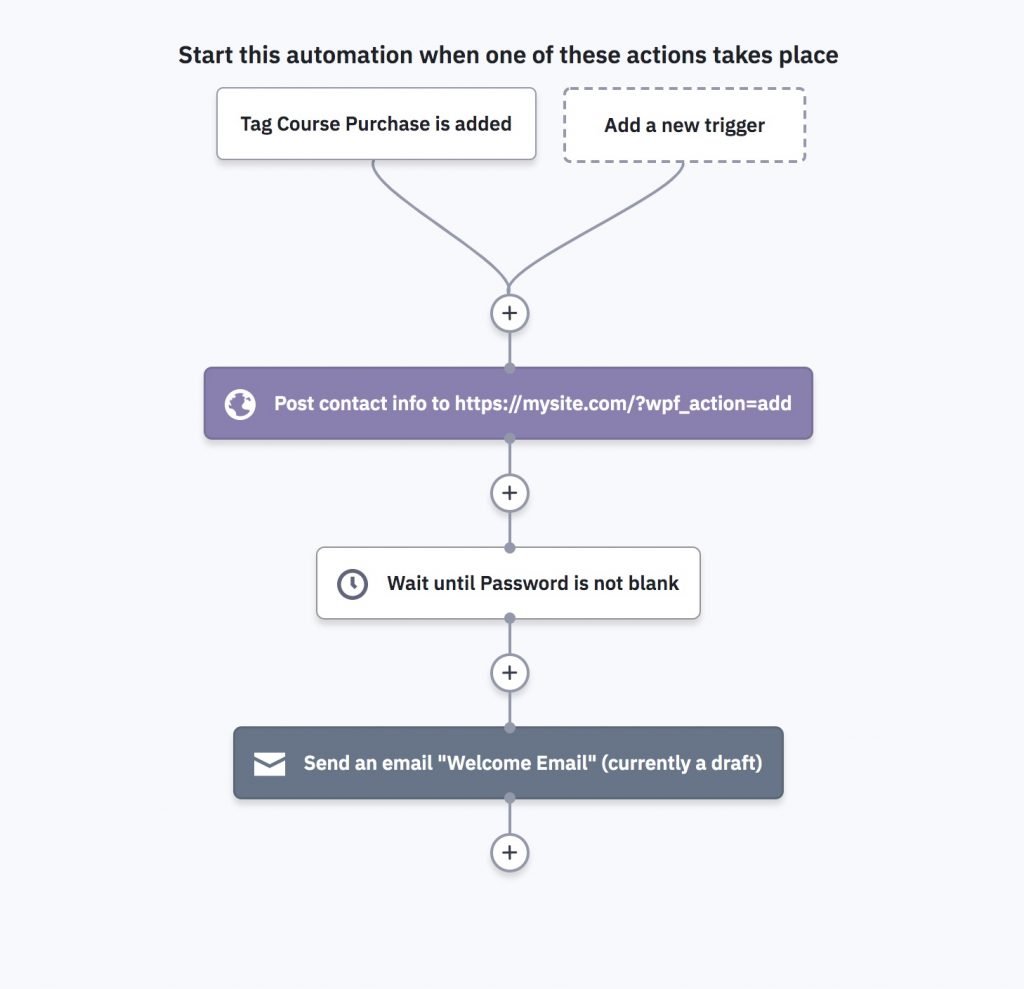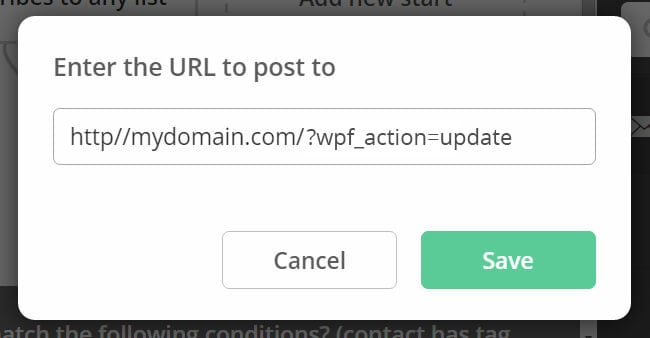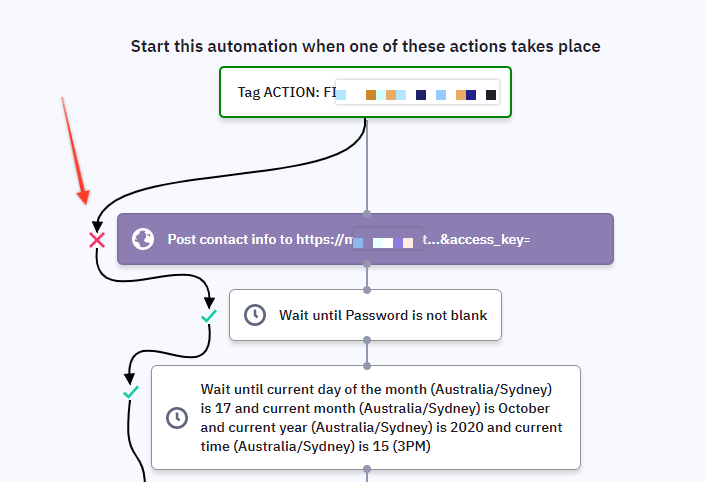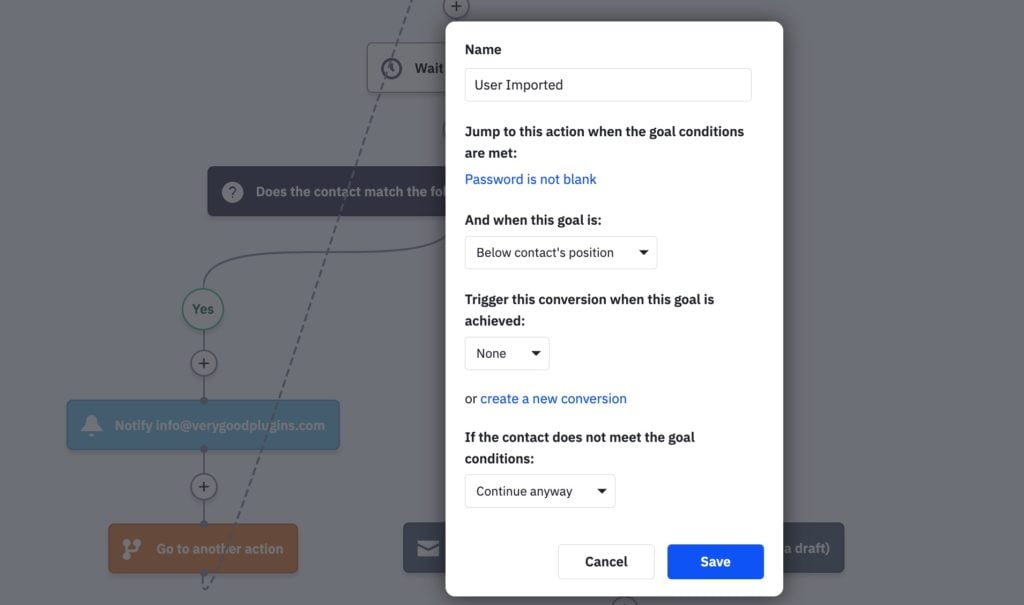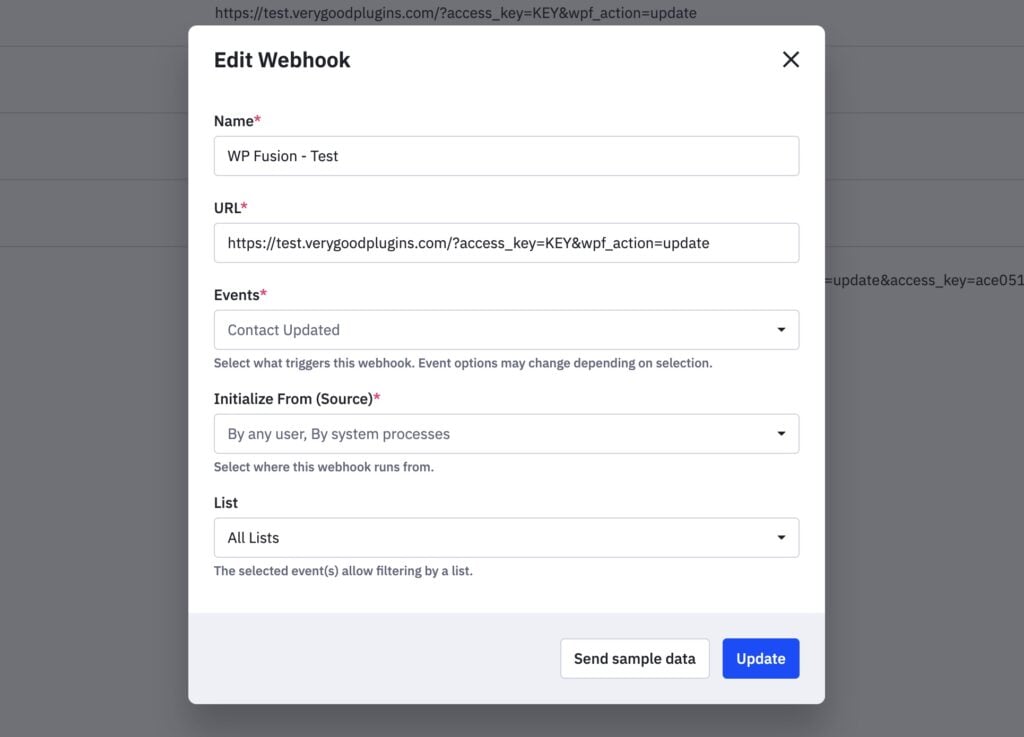#Overview
You can use webhooks in ActiveCampaign to send data back to your WordPress site using WP Fusion. Using webhooks you can create new users on your WordPress site based on automations in ActiveCampaign, or update existing users’ meta data and tags.
There are two ways to manage webhooks in ActiveCampaign, either via an Automation or in the Developer Settings.
#Automation method
(Recommended) The automation method is best if you need to send a webhook to create or update a WordPress user as part of a specific process. For example:
- Tag “Website Access” is added
- Send webhook to create WordPress user
- Send welcome email
- Wait 3 days
- Apply tag “Unlock Course Two”
- Send webhook to update tags
Using a webhook in an automation lets you easily visualize the entire automation flow, and see where individual contacts are in the process.
You’ll also be able to visualize where a single contact is in the automation, when the webhook was sent, and whether or not it was received successfully. Using webhooks in automations gives you a lot more control and better reporting than using Global Webhooks (see below).
To use webhooks in automations first create an automation and add a webhook to it, like in the example above. You have three options for the webhook, update, update_tags and add (explained below). For each you will need to supply your access key, which can be obtained from the main panel in your WP Fusion settings.
When the contact reaches the webhook step in the automation ActiveCampain will notify WP Fusion to load the contact’s data from ActiveCampaign.
#A note on “failed” webhooks
When viewing automation reports you may see your webhooks being marked as “failed” by ActiveCampaign, like in the screenshot below.
This does not necessarily mean that the webhook failed. ActiveCampaign will mark any webhook as failed if your server takes longer than 5 seconds to respond.
Since there’s a fair deal of processing involved in receiving a webhook (see some average timings here), it’s not uncommon for your server to take longer than 5 seconds, especially with shared hosting.
For a definitive answer as to whether the webhook was processed, you can check the WP Fusion logs.
If you’d prefer not to see the Failed symbol in the automation reports, you can also set your webhooks to run asynchronously.
This does not speed up the time required to process the webhook, or make webhooks more reliable, it just means that WP Fusion will immediately respond to ActiveCampaign that every webhook was successful, and then actually process the webhook a few seconds later.
#Verifying that webhooks worked
There are some cases where a webhook to import a new user might fail— like if your site is briefly unavailable while installing updates, or ActiveCampaign’s API takes too long to load the data for the new user, and times out.
If you’re experiencing unreliable webhooks you may want to set up a notification and/or an automatic retry. Take a look at the example below, or click here to load the example template into your ActiveCampaign account.
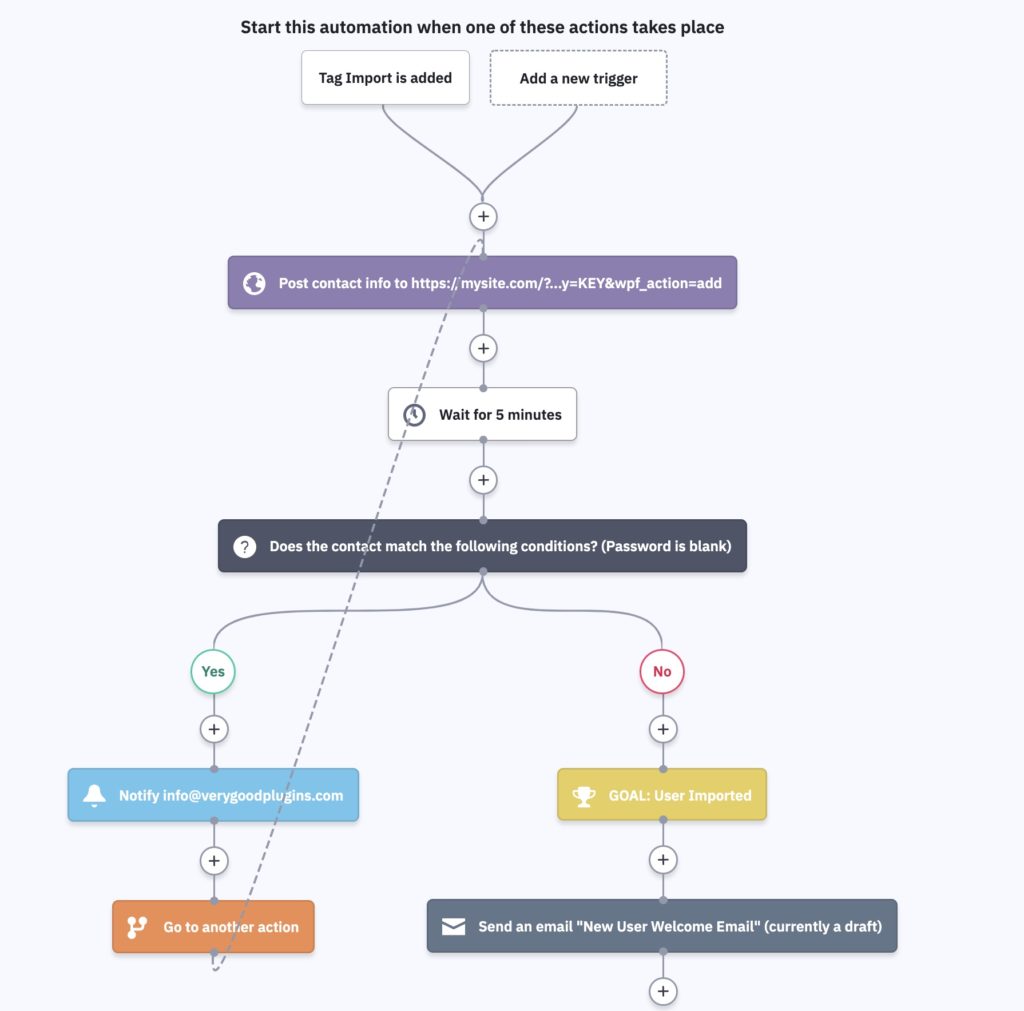
Since we’re generating a password and syncing it back to ActiveCampaign, you can check against the value of this field to see if the webhook worked (you could also check against a tag, or the User ID field).
In this automation we have a 5 minute wait after sending the webhook. If the contact’s Password field is blank, the automation first sends a notification to an admin, and then retries the webhook.
The User Imported goal is set up like so:
Using the condition Password is not blank means that if any time the contact’s password is updated, they will immediately jump to the goal, and then proceed on to the next step which sends a welcome email.
This means that if everything is running properly, the new user will be imported and a welcome email sent within a few seconds. But if there are any delays or errors, a notification will be sent to an admin within five minutes— you can then investigate the contact to see why they weren’t imported successfully (i.e. an invalid email address) or let the retry cycle run the webhook again.
#Developer settings method
(Advanced) You can also set up webhooks which are global to your account. This is best if you’re manually editing contact records in ActiveCampaign (outside of an automation) and need these changes synced to WordPress.
add method, as then every contact in ActiveCampaign will be given a WordPress user account.To set up a webhook navigate to Developer » Webhooks in your ActiveCampaign admin settings, and click Add to create a new webhook.
For URL enter the URL to your site with your access key following the patterns in the next section.
Under Events select the events that should trigger the webhook:
- Contact Updated will be triggered whenever a contact is edited, as well as when tags are applied or removed.
- Contact Tag Added and Contact Tag Removed will only be triggered when tags are edited, not when a contact’s custom fields change.
For Initialize From, select which types of events should trigger the webhook. ActiveCampaign has a description of the types here.
You shouldn’t enable By the API as this will send a webhook after WP Fusion sends an API call to apply a tag, which is redundant.
Note that, despite the descriptions in the ActiveCampaign help portal, we have tested and found that tags applied in automations will trigger a global webhook if it is set to By any user. If you’re experiencing unexpected webhooks or a high volume of webhooks, it’s recommended to disable that trigger.
Note: November 21st, 2023. We have confirmed with ActiveCampaign support that By any user is also triggered by API calls. This means it is not currently possible to trigger webhooks based on manual contact edits without also triggering them based on API activity.
This is acknowledged as a bug, but they are only releasing the fix on an account-by-account basis. If you want to sync manual contact edits back to WordPress using global webhooks, you should contact ActiveCampaign support and ask for this fix to be enabled on your account— so that By any user webhooks are only triggered by users and not API activity.
Keep in mind that, because these webhooks are global to your ActiveCampaign account, bulk editing contacts will trigger webhooks to be sent to your site for every edited contact, which may make your WordPress site temporarily unstable.
update or update_tags method it’s not necessary to also include those same webhooks in automations.#Webhook URL parameters
You can format your webhook URL in a few different ways to customize the behavior:
#To update a user’s tags
To update an existing WordPress user’s tags from the contact record, the URL for the webhook should look like the following:
https://mydomain.com/?wpf_action=update_tags&access_key=YOURACCESSKEY
#To update a user’s tags and meta data
To update a user’s tags and pull any new meta data from ActiveCampaign for that contact, the URL for the webhook should look like the following:
https://mydomain.com/?wpf_action=update&access_key=YOURACCESSKEY
#Create a new user
To create a new user, use the following URL:
https://mydomain.com/?wpf_action=add&access_key=YOURACCESSKEY
You can also specify additional parameters in user creation. For example, to send the user a welcome email containing a link to log in on your site, use the following:
https://mydomain.com/?wpf_action=add&access_key=YOURACCESSKEY&send_notification=true
You can also specify a specific user role to be assigned to the new user. For example, to set the new user to the “customer” role, use the following:
https://mydomain.com/?wpf_action=add&access_key=YOURACCESSKEY&role=customer
Note that you have to have registered a “customer” role on your site for this to work. By default users will be assigned the role of “subscriber”.
The add method will update a user if an existing user already exists. It will not create a duplicate user.
user_login and user_pass on your website, the new users will be given the usernames and passwords stored in their ActiveCampaign contact record.#User passwords
New user accounts will be created with an automatically generated password. If you’d like to use this password in your email marketing, you can send the password back to ActiveCampaign after it has been generated.
In the Webhooks section of the General settings tab, check the box for Return Password, and select a field in ActiveCampaign where the password should be stored.
After a new user is created, their automatically generated password will now be saved back to their contact record, and you can use a merge field to include it in an email. The username will be the contact’s email address.
